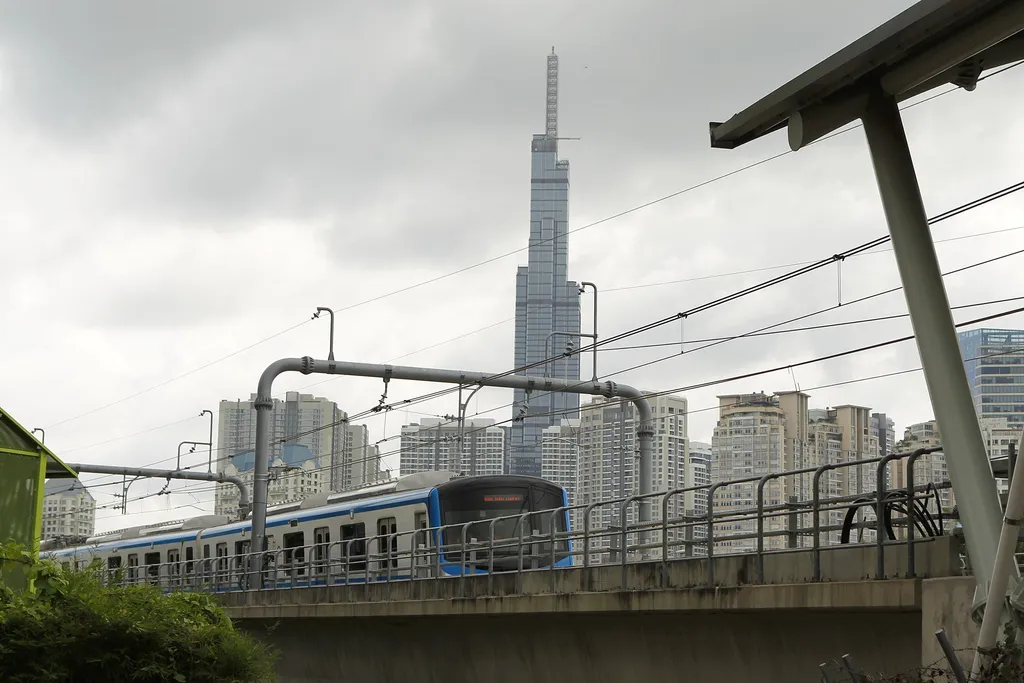 Society
Society

 |
| Chairman of Hà Nội’s People's Committee Trần Sỹ Thanh delivers an opening speech at the three-day seminar on the development of urban railway systems in Hà Nội and HCM City on Wednesday. VNS Photo Khánh Linh |
HÀ NỘI – Major urban centres in Hà Nội and HCM City are in need of legal frameworks and innovative policy mechanisms to implement and advance urban railway systems based on the Transit-Oriented Development (TOD) model in the near future, as discussed in a seminar held yesterday.
The three-day seminar on the development of urban railway systems in Hà Nội and HCM City, which commenced on Wednesday, underscored the significance of urban development after the TOD model, with a specific focus on public transport nodes, primarily rail stations, to incorporate diverse functionalities.
The event, jointly organised by the People's Committees of the two cities, attracted the participation of nearly 400 domestic and international experts and analysists.
In his opening speech, Chairman of Hà Nội’s People's Committee Trần Sỹ Thanh emphasised that public transportation played a crucial role for Hà Nội and HCM City, the economic locomotives of the country and the two largest cities in terms of area and population. Urban railway systems were considered the "backbone" of the transportation infrastructure network.
Thanh said early investment and efficient operation of urban railway systems would increase the share of public passenger transport and reduce private vehicle traffic, thereby bringing positive effects for socio-economic development, environmental pollution reduction, and traffic congestion.
The seminar focused on exchanging experiences on the TOD model, along with tools for capturing value from land. These were two aspects expected to provide new solutions for the construction of the urban railway networks of the two cities soon, he said.
Deputy Chairman of HCM City’s People's Committee Bùi Xuân Cường cited Conclusion 49 of the Politburo, which sets the goal of completing the urban railway network in Hà Nội and HCM City within 12 years.
"This is a challenging task, and if we continue to implement it in the same way as in the past 20 years, we cannot achieve this goal," he said, adding that both cities have determined to coordinate to make breakthroughs in the construction of urban railways linked to TOD in the upcoming time.
The development of urban areas according to the TOD model is defined as an urban development model centred around public transportation, enhancing accessibility and convenience for citizens to reach transit points and urban railway stations. This approach aims to minimise reliance on personal vehicles, promote the use of public transportation, and create sustainable and eco-friendly urban areas.
The success of the TOD model would require thorough research and careful preparation, including planning issues, legal foundations and collaboration among departments and agencies to swiftly innovate corresponding legal systems, he said.
According to Hà Nội’s master plan for transportation, the city's urban railway network is envisioned to comprise nine lines totalling 417.8km, including 75.6km underground, by 2030. Currently, the 13km-long Cát Linh – Hà Đông urban railway is operational, and construction is underway for the 12.5km Nhổn – Hà Nội Station line.
Meanwhile, HCM City sets the goals of having eight urban railway lines running a total length of 172.6km, along with three ground-level monorail lines spanning 56.5km. The city is currently implementing Metro Line 1 running from Bến Thành Market in District 1 to Suối Tiên Theme Park in Thủ Đức City and Metro Line 2 between Bến Thành Market and Tham Lương in District 12.
Đặng Huy Đông, head of the Institute for Research Planning and Development, said to achieve the goal of completing the urban railway networks in Hà Nội and HCM City by 2035 as outlined in Conclusion 49, truly innovative thinking and a new legal framework tailored specifically for the two cities were needed.
"The goal of constructing a 400km urban railway system by 2035 requires breakthrough mechanisms and policies in areas such as planning, land compensation and recovery, financial resources, procedures, investment, construction, technical standards, technology, supply of equipment and materials, and human resource development," he stressed.
Professor Vũ Minh Khương from Singapore-based Lee Kuan Yew School of Public Policy said urban railway development based on the TOD model would enhance societal productivity by reducing daily commuting costs for citizens, increase job opportunities, elevate the value of real estate and urban landscapes, and improve the efficiency of the retail and service sectors through the development of shopping and service centres around railway stations.
He asserted that the lack of special emphasis on developing urban railway systems would lead to substantial and escalating losses, including time spent on commuting, unreliable travel time estimates, excessive fuel consumption costs, increased emissions due to excessive fuel consumption, and a decline in the health and trust of the population.
Referring to Forbes' calculations, Khương stated that traffic congestion annually causes damages of at least US$2-3 billion per city in Hà Nội and HCM City.
Addressing several directions and strategies for building and developing urban railway systems following the TOD model, Khương suggested that each city should embark on several experimental routes with criteria such as high feasibility, significant impact, low land acquisition costs and investor interest.
The completion time for these experimental projects should be before 2030, focusing on three major criteria: quality, cost and implementation progress.
Khương said Việt Nam should consider urban railways as a strategically vital industry, and investments in developing human resources, supporting industries, international cooperation capabilities, and project management expertise should be top priorities. The most talented experts should be mobilised to consult and support the two cities in urban railway development in the coming years.
Regarding the solution on financial resources for project implementation, Đặng Huy Đông pointed out that currently, an estimated $20-25 billion was needed to complete the construction of 200km of entirely underground urban railways, excluding compensation costs for land clearance.
Therefore, it was necessary to allow the two cities to retain land auction proceeds for direct investment in metro system development projects through the auction of development rights for TOD urban areas. The two cities should be allowed to issue local bonds, project bonds, or other lawful forms of fundraising beyond the annual public debt ceiling applied to cities each year and throughout the period until 2035 to ensure sufficient funding for the development of the 200km metro system, he said. — VNS
 |
| Trial run of HCM City's first metro project. — VNA/VNS Photo Thanh Vũ |




